Photonic technologies are probing the link between quantum mechanics and biological processes ranging from avian navigation to photosynthesis to consciousness itself.
FAROOQ AHMED, CONTRIBUTING EDITOR
In Erwin Schrödinger’s 1944 book, What Is Life? The Physical Aspect of the Living Cell, the Nobel Prize-winning physicist and one of the fathers of quantum mechanics speculates on a quantum theory of biology. It is one of the earliest attempts to reconcile how, as Schrödinger puts it, “living matter, while not eluding the laws of physics as established up to date, is likely to involve ‘other laws of physics’ hitherto unknown”1.

It has taken nearly eight decades and the invention of the tabletop laser and advanced spectroscopic techniques to begin elucidating the mechanisms at work in the field now known as quantum biology. Quantum mechanical phenomena have been implicated throughout the natural world, likely informing the “other laws of physics” that underlie seemingly mysterious processes such as anesthesia and magnetic field sensing in birds.
But, perhaps fittingly, some uncertainty remains when determining whether these and other biological systems are truly governed by quantum mechanics.
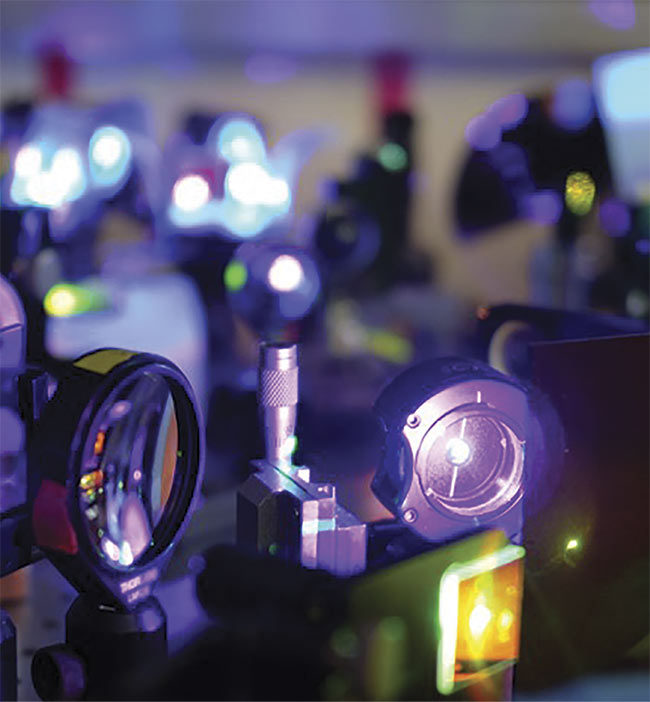
A noncollinear optical parametric amplifier employed to generate broadband visible pulses during
investigations into quantum oscillations in light-harvesting complex II (LHCII), which is the major antennae
of chlorophyll. Courtesy of Yusuke Yoneda/University of California, Berkeley.
Clarice Aiello, UCLA assistant professor of electrical and computer engineering, believes the field of quantum biology has recently reached a turning point — one that has arrived through a combination of theoretical advancements, increased investment, growing interest in quantum technologies, and expanding collaboration between physicists, engineers, and biologists.
“I like to think we’re where quantum computing was in the 1990s — transitioning from theory to experiment, with instrumentation driving us forward,” Aiello said. Last year, she established the Quantum Biology Tech (QuBiT) Lab at UCLA, where she aims to treat biological organisms as “living quantum sensors” and to perform experiments inspired by quantum computing techniques.
Prem Kumar, a professor of information technology at Northwestern University, shares Aiello’s perspective of the field, citing the National Quantum Initiative Act as a major milestone. The act tasks the National Science Foundation with promoting quantum information science and engineering, and establishing grants for multidisciplinary centers for quantum research and education, among other provisions.
“There is no reason to think that evolution wouldn’t take advantage of whatever it needed — the full range of physical processes, including quantum ones,” he said. Kumar spent four years, from 2013 to 2017, as a program manager in the Defense Sciences Office at DARPA, where he oversaw the Quantum Effects in Biological Environments program.
According to Aiello, advanced photonic technologies are necessary for quantum biological investigations because quantum effects occur orders of magnitude faster than chemical reactions. “Ultrafast processes at femtosecond timescales do end up influencing physiology at much longer timescales in cells,” she said. “Correlation between these disparate timescales can be recorded and studied with appropriate instrumentation.”
The spin on spin
‘There is no reason
to think that evolution wouldn’t take advantage
of whatever it needed — the full range of physical processes, including
quantum ones.’
— Prem Kumar
Magnetic field sensing in birds is an example of a biological process thought
to be mediated by a quantum property — in this case, spin. In quantum mechanics, spin describes the angular momentum of an elementary particle such as an electron, and it can be manipulated by magnetic fields. Spin is important in
biology, said Aiello, because it can influence the path that a chemical reaction takes.
Her group is in the process of building a spin-sensing experiment under a lattice light-sheet microscope. Developed about six years ago, lattice light-sheet microscopy combines elements of fluorescent, Bessel beam, and structured light microscopy. It allows researchers to image samples over vast scales — from single molecules to clusters of cells — with high spatiotemporal resolution. The technique also leaves biological specimens and fluorophores mostly unharmed. Aiello described it as a vast improvement over confocal microscopy.
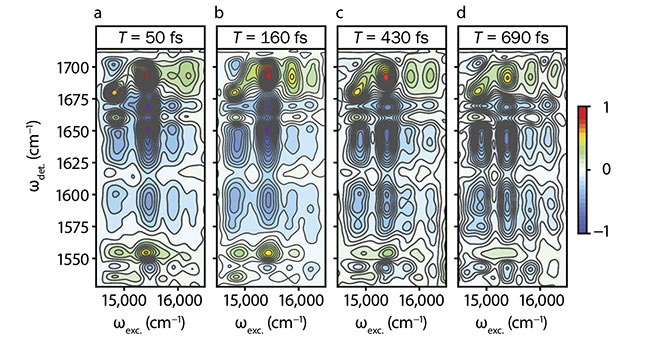
2D electronic-vibrational (2DEV) spectroscopy spectra of LHCII at waiting times of 50, 160, 430, and 690 fs (a-d). Positive features indicate ground-state bleaches, and negative features indicate excited-state absorptions. The intensities of all spectra have been normalized to T = 0 fs. Contour lines are drawn in 6.6% intervals. The region of the linear absorption spectrum of LHCII (at 77 K) that was excited during this experiment, along with the excitonic states, has been placed at the top of each of the 2DEV spectra in (a-d). The grouping of red and pink lines distinguishes the excitonic band of mainly chlorophyll a character, while the grouping of blue lines distinguishes the excitonic band of mainly chlorophyll b character. The purple continuum highlights the region of the absorption spectrum composed of the higher-lying vibronic states of mixed chlorophyll character. In (b), excited-state absorption features of interest have been labeled. Courtesy of Graham Fleming University of California, Berkeley.
“Because of the noisy environment inside cells, it can be difficult to say that, for example, what’s happening in a bird is unambiguously following a quantum phenomenon. And that’s something we want to see at the nanoscale,” she said. She envisions using a large, two-dimensional array of single-photon detectors to image spin manipulation inside cells.
“It’s like my dream Christmas gift, to have a nanosecond time resolution for each pixel,” Aiello said.
Clocking photosynthesis
Unlike magnetic field sensing, photosynthesis is one biological process in which the importance of quantum interactions is starting to become clearer thanks to advancements in spectroscopy. In 2007, Graham Fleming, professor of chemistry at the University of California, Berkeley, led a group that used two-dimensional electronic spectroscopy to show quantum oscillations in a bacterial photosynthetic complex2. In theory, these oscillations allow an incoming photon to chart the quickest and most efficient path to the reaction center, where it is converted into an energy form that is useful for an organism.
Efficiency is crucial for reactions that involve light-harvesting such as photosynthesis. “As soon as a photon is absorbed, the clock starts,” Fleming said. “It needs to initiate chemistry without losing energy or being reemitted.”
This research, he added, started a debate as to whether quantum mechanics actually plays a role in electronic energy transport in photosynthesis.
Over the past five years, Fleming’s group refined a method that they developed to study these oscillations: Two-
dimensional electronic-vibrational (2DEV) spectroscopy3 borrows a technique called “phase-cycling” from nuclear magnetic resonance to reconcile the wavelengths — infrared and visible — necessary to activate photosynthetic complexes and to distinguish the movement of electrons within a structure from quantum vibrations. The coupling of electronic and vibrational motions contributes to the generation of quantum oscillations like the ones Fleming initially observed. (See figure above.)
In March, his group used 2DEV spectroscopy to map quantum oscillations in light-harvesting complex II (LHCII) — the major antennae of chlorophyll and arguably the most important light-to-energy conversion complex on Earth4.
“If you see a satellite picture of the earth, most of the green is LHCII,” said Fleming. “It’s where half the chlorophyll on the planet is.”
Despite these results, much work still needs to be done to prove that LHCII exploits quantum oscillations in photosynthesis. Graduate student Eric Arsenault, who led the Fleming group’s 2DEV spectroscopy experiment, said improvements in mid-infrared pulse generation and detection would aid their studies. “We need the pulses to have sufficient energy so that we can observe a signal, and then we need them to be ultrafast,” he said.
As the technology improves, Fleming believes it will be possible to unambiguously discern whether or not quantum
mechanics influence how biological systems and processes evolve. “At the
moment, we can’t,” he said.
Entangled consciousness
One of life’s great mysteries, the biological origin of consciousness, has proven to involve “other laws of physics,” as Schrödinger might have put it. Attention has turned to quantum biology to help solve the mystery, prompted in part by research into general anesthetics, which seem to be able to switch consciousness off. As biophysicist Luca Turin once said, “The only thing we are sure about consciousness, is that it is soluble in chloroform.”
Despite the widespread use of general anesthetics for well over a century, the mechanism behind their action is not well understood. This problem is compounded by the fact that different types of molecules, from the noble gas xenon to more complex ethers, can act as general anesthetics across a variety of species.
In 2014, Turin, then at the Alexander Fleming Biomedical Sciences Research Center in Greece, joined other researchers to conduct electron spin resonance experiments that demonstrated that several general anesthetics, including xenon and chloroform, cause spin changes in Drosophila (common fruit flies) when compared to anesthetic-resistant fruit flies. The group speculated that the anesthetics acted by disturbing the electronic structure of proteins5.
UCLA’s Aiello cautions that this conclusion is controversial. However, additional proof for the involvement of quantum interactions in anesthetics came last year when University of Michigan
professor of chemistry Theodore Goodson and colleagues delivered the first evidence that halogenated anesthetic ethers can directly interact with entangled photons6.
Entanglement, which Schrödinger helped to elucidate, is one of the strangest quantum mechanical phenomena. Albert Einstein famously called it “spooky action at a distance.” Though each is physically separate from the other, entangled particles act as if they are tethered together: The perturbation of one results in the perturbation of the other, even across vast distances.
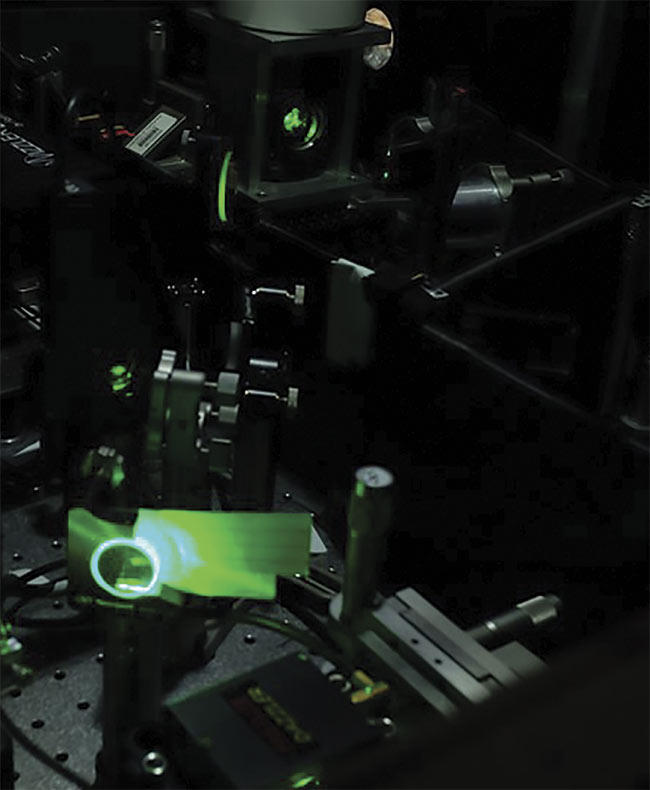
The 2DEV spectroscopy experiment from Graham Fleming’s laboratory. Visible pump pulses
and infrared probe pulses interact with samples to generate a 2DEV spectroscopic signal. Courtesy of Yusuke Yoneda/University of California, Berkeley.
Goodson said that recent improvements in entangled photon generation greatly aided his work. “We have had visiting faculty, postdocs, graduate and undergraduate students, as well as my son in high school, create entangled photons by SPDC.”
Spontaneous parametric down conversion (SPDC) is a technique through which one higher-energy photon is converted into two photons of lower energy that can emerge entangled. The Michigan researchers used a slew of spectroscopic techniques, including entangled two-photon spectroscopy, to demonstrate an interaction between the anesthetics sevoflurane and isoflurane and pairs of 800-nm entangled photons.
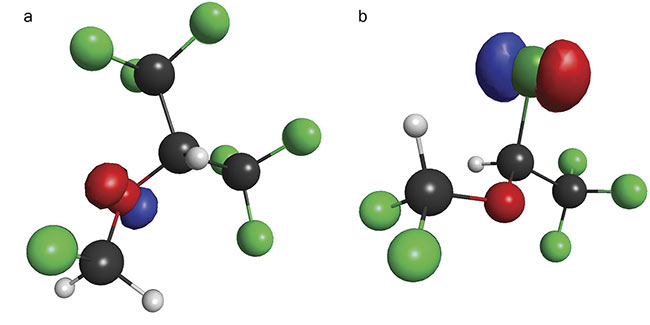
The highest occupied molecular orbital image for the halogenated ethers sevoflurane (a) and isoflurane (b). Theodore Goodson and colleagues demonstrated that these general anesthetics interact with entangled photons. Courtesy of Theodore Goodson/University of Michigan.
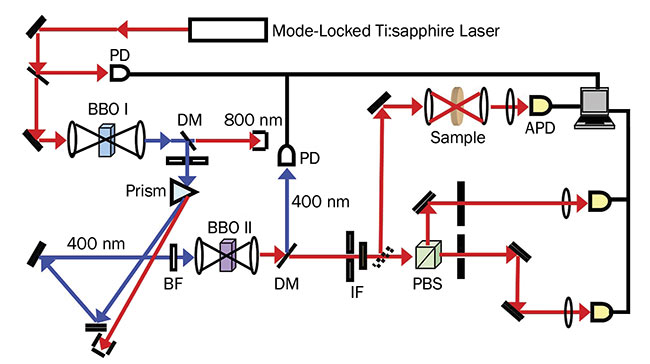
A sketch of the experimental setup used by Goodson and colleagues for entangled two-photon spectroscopy. Orthogonally polarized entangled photon pairs were generated by the spontaneous parametric down-
conversion (SPDC) process. A 0.5-mm β-Barium borate (BBO) crystal (type II) is pumped with the second-harmonic generation beam (400 nm) of a Ti:sapphire laser emitting ~70 fs pulses. Entangled photon intensity is varied by changing the pump power on the SPDC crystal with a variable neutral density filter. Transmitted entangled photons are focused onto an avalanche photodiode (APD). PD: photodiode; DM: dichroic mirror;
BF: bandpass filter; IF: interference filter; PBS: polarizing beamsplitter. Courtesy of Theodore Goodson/University of Michigan.
However, the researchers have not determined whether or how this interaction operates on a biological level. “We’re still trying to get a handle on the structure-function relationships, which can ultimately lead to an understanding of what happens in biology. But there’s a lot to be done before you can prove things like quantum consciousness,” Goodson said.
The efficiency of SPDC at generating
entangled photons is very low, he said, and instrumentation could be both improved and miniaturized.
Goodson also emphasized the role that small or boutique instrument companies play for scientific researchers. “They’ll customize a laser or a setup for us; they allow us to do something extra,” he said. “Frankly, we need them, and I hope they survive the [COVID-19] pandemic.”
Northwestern’s Kumar and UCLA’s Aiello remain optimistic about quantum biology’s ability to solve nature’s mysteries. Kumar noted that computational methods that leverage artificial intelligence coupled with physical experiments have proven valuable in other fields and are helping quantum biologists interpret their data.
“It’s a no-brainer,” he said. “Computational tools will pay huge dividends.”
For Aiello, instrumentation has been the bottleneck, but she has seen signs of improvement.
“New technologies will help us bridge those landscapes — from the quantum effects on proteins, to cells, and finally to organisms,” she said.
www.linkedin.com/in/farooqtheahmed
Acknowledgments
The author would like to thank Clarice Aiello, UCLA; Prem Kumar, Northwestern University; Graham Fleming and Eric Arsenault, the University of California, Berkeley; and Theodore Goodson, the University of Michigan.
References
1. E. Schrödinger (1944).
What Is Life?
The Physical Aspect of the Living Cell.
Cambridge, England: Cambridge University Press.
2. G. Engel et al. (2007). Evidence for wavelike energy transfer through quantum coherence in photosynthetic systems. Nature, Vol. 446,
pp. 782-786, www.nature.com/articles/nature05678.
3. T. Oliver et al. (2014). Correlating the
motion of electrons and nuclei with two-dimensional electronic-vibrational spectroscopy. Proc Natl Acad Sci, Vol. 111, Issue 28, www.pnas.org/content/111/28/10061.
4. E. Arsenault et al. (2020). Vibronic mixing enables ultrafast energy flow in light-harvesting complex II. Nat Commun,
Vol. 11, Article 1460, www.nature.com/articles/s41467-020-14970-1.
5. L. Turin et al. (2014). Electron spin changes during general anesthesia in Drosophila. Proc Natl Acad Sci, Vol. 111, Issue 34, www.doi.org/10.1073/pnas.1404387111.
6. R. Burdick et al. (2019). Modern anesthetic ethers demonstrate quantum interactions with entangled photons. Sci Rep, Vol. 9, Article 11351, www.nature.com/articles/s41598-019-47651-1.